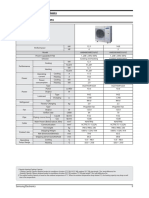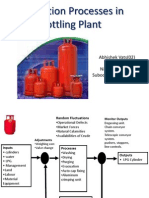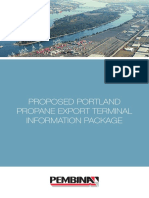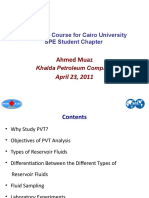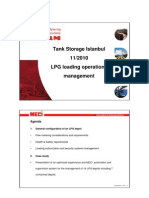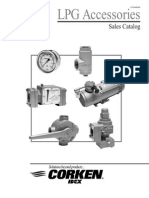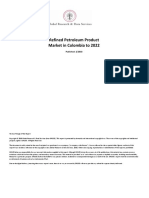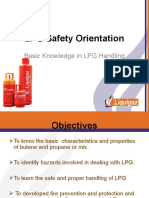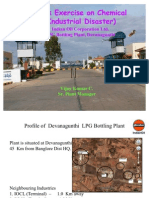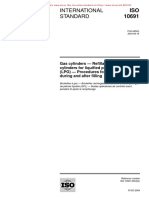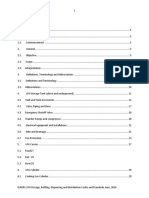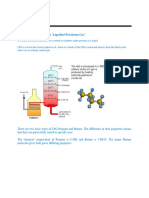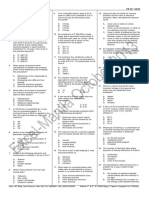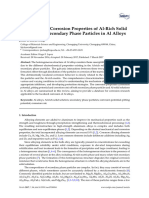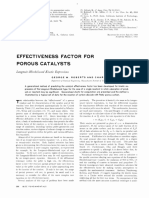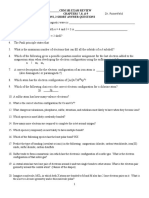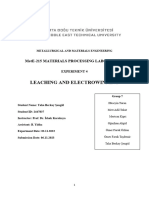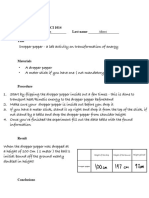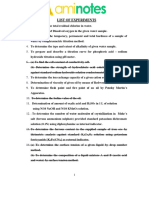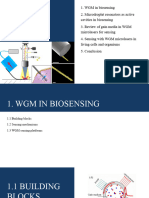Liquefied Petroleum Gas
Liquefied Petroleum Gas
Uploaded by
jacuzzisCopyright:
Available Formats
Liquefied Petroleum Gas
Liquefied Petroleum Gas
Uploaded by
jacuzzisCopyright
Available Formats
Share this document
Did you find this document useful?
Is this content inappropriate?
Copyright:
Available Formats
Liquefied Petroleum Gas
Liquefied Petroleum Gas
Uploaded by
jacuzzisCopyright:
Available Formats
Liquefied Petroleum Gas
What is LPG or LP Gas?
LPG or LP Gas is the abbreviation of Liquefied Petroleum Gas. This group of products
includes saturated Hydrocarbons - Propane (C3H8) and Butane (C4H10), which can be
stored/transported separately or as a mixture. They exist as gases at normal room
temperature and atmospheric pressure.
Why is it called Liquefied Petroleum Gas?
This is because these gases liquefy under moderate pressure. They liquefy at moderate
pressures, readily vaporizing upon release of pressure. It is this property that permits
transportation of and storage of LP Gas in concentrated liquid form.
Where does LPG come from?
LPG comes from two sources. It can be obtained from the refining of crude oil. When
produced this way it is generally in pressurized form. LPG is also extracted from natural gas
or crude oil streams coming from underground reservoirs. 60% of LPG in the world today is
produced this way whereas 40% of LPG is extracted from refining of crude oil.
What is commercial Propane & Butane?
Ideally products referred to as "propane" and "butane" consist very largely of these
saturated hydrocarbons; but during the process of extraction/production certain allowable
unsaturated hydrocarbons like ethylene, propylene, butylenes etc. may be included in the
mixture along with pure propane and butane. The presence of these in moderate amounts
would not affect LPG in terms of combustion but may affect other properties slightly (such
as corrosiveness or gum formation).
How is LPG seen & felt?
• It is colorless and cannot be seen
• It is odorless. Hence LPG is odorized by adding an odorant prior to supply to the
user, to aid the detection of any leaks.
• It is slightly heavier than air and hence if there is a leak it flows to lower lying areas.
• In liquid form, its density is half that of water and hence it floats initially before it is
vaporized.
• It is non-toxic but can cause asphyxiation in very high concentrations in air.
LPG expands upon release and 1 liter of liquid will form approximately 250 liters of vapor
What is LPG used for?
LPG is used as a fuel for domestic (cooking), industrial, horticultural, agricultural, heating
and drying processes. LPG can be used as an automotive fuel or as a propellant for
aerosols, in addition to other specialist applications. LPG can also be used to provide
lighting through the use of pressure lanterns.
Why are Butane and Propane used in combination?
While butane and propane are different chemical compounds, their properties are similar
enough to be useful in mixtures. Butane and Propane are both saturated hydrocarbons.
They do not react with other. Butane is less volatile and boils at 0.6 deg C. Propane is more
volatile and boils at - 42 deg C. Both products are liquids at atmospheric pressure when
cooled to temperatures lower than their boiling points. Vaporization is rapid at temperatures
above the boiling points. The calorific (heat) values of both are almost equal. Both are thus
mixed together to attain the vapor pressure that is required by the end user and depending
on the ambient conditions. If the ambient temperature is very low propane is preferred to
achieve higher vapor pressure at the given temperature.
What are the advantages of LPG?
The advantages of LPG are as follows
• Because of its relatively fewer components, it is easy to achieve the correct fuel to
air mix ratio that allows the complete combustion of the product. This gives LPG its
clean burning characteristics.
• Both Propane and Butane are easily liquefied and stored in pressure containers.
These properties make the fuel highly portable, and hence, can be easily transported
in cylinders or tanks to end-users.
• LPG is a good substitute for petrol in spark ignition engines. Its clean burning
properties, in a properly tuned engine, give reduced exhaust emissions, extended
lubricant and spark plug life.
• As a replacement for aerosol propellants and refrigerants, LPG provides alternatives
to fluorocarbons, which are known to cause deterioration of the earth's ozone layer.
The clean burning properties and portability of LPG provide a substitute for traditional fuels
such as wood, coal, and other organic matter. This provides a solution to de-forestation and
the reduction of particulate matter in the atmosphere (haze), caused by burning the
traditional fuels.
What are LPG properties?
Commercial Commercial Mixture 50%
Property Units
Propane Butane each
Specific gravity of Liquid
0.504 0.582 0.543
at 15 deg C (Water=1)
Specific gravity of Vapor
1.5 2.01 1.75
at 15 deg C(Air=1)
Vapor pressure at 38 Kg/sq.cm
13.8 2.6 8.0
deg C
Boiling point at atm Deg C
- 42 9 + 9 to - 42
pressure
Ignition temperature in air Deg C 495-605 480-535 480-605
Latent Heat of Btu/lb
184 167 175
Vaporization
http://www.e-lpg.com/lp_gas.asp
You might also like
- AM050KXMDCH AzDocument1 pageAM050KXMDCH AzShirley BarreraNo ratings yet
- The Story of LPG PDFDocument242 pagesThe Story of LPG PDFOctavian StoichitaNo ratings yet
- LPG TableDocument3 pagesLPG TablekumarNo ratings yet
- No. Title Page No.: IndexDocument43 pagesNo. Title Page No.: IndexAbbas ALhasnawyNo ratings yet
- 1.1.1 LPG 1.1.2viscosity 1.1.3 Vapor Pressure 1.1.4 Specific Gravity 1.1.5 Flame Temperature 1.1.6 Flash Point 1.1.7 Odorization of LPG 1.1.8 Colour 1.1.9 ToxicityDocument6 pages1.1.1 LPG 1.1.2viscosity 1.1.3 Vapor Pressure 1.1.4 Specific Gravity 1.1.5 Flame Temperature 1.1.6 Flash Point 1.1.7 Odorization of LPG 1.1.8 Colour 1.1.9 ToxicityzeyadNo ratings yet
- PropaneDocument6 pagesPropaneFERNANDO JOSE NOVAESNo ratings yet
- LPG Induction Course NewDocument28 pagesLPG Induction Course NewMha RizNo ratings yet
- LPG ResidentialDocument40 pagesLPG Residentialkhabbab hussain100% (1)
- Characteristics of LPGasDocument8 pagesCharacteristics of LPGasAnkita KulshreshthaNo ratings yet
- LPG Gas SafetyDocument22 pagesLPG Gas SafetyLex FrancisNo ratings yet
- Lpgbottlingplant 12494506726011 Phpapp03Document15 pagesLpgbottlingplant 12494506726011 Phpapp03mdashrafalamNo ratings yet
- Project of MPOL LPGDocument24 pagesProject of MPOL LPGroihyNo ratings yet
- Liquefied Petroleum GasDocument9 pagesLiquefied Petroleum Gaslistyani100% (1)
- LPG As Fuel PDFDocument8 pagesLPG As Fuel PDFNatesha SundharanNo ratings yet
- Propane Terminal ProjectDocument20 pagesPropane Terminal ProjectCrystal Davis100% (3)
- OLPG S1-01 - OESA LPG Depots and Filling PlantsDocument38 pagesOLPG S1-01 - OESA LPG Depots and Filling PlantsGogne Rodolph100% (1)
- LPG SafetyDocument28 pagesLPG Safetybenaoumeur benouna0% (1)
- Boi Questionairre For Loans Above N 10 MillionDocument21 pagesBoi Questionairre For Loans Above N 10 MillionAdegboyega AdeyemiNo ratings yet
- Natural Gas AssignmentDocument9 pagesNatural Gas AssignmentJagathisswary SatthiNo ratings yet
- LPG Loading and Unloading Arms - Technical Specification - Hindustan Petroleum CompanyDocument36 pagesLPG Loading and Unloading Arms - Technical Specification - Hindustan Petroleum CompanyDayo Idowu100% (2)
- SRS - New Edit On 11 09 2020Document12 pagesSRS - New Edit On 11 09 2020Rida ChNo ratings yet
- L-545 Servicemans ManualDocument56 pagesL-545 Servicemans ManualingenerproNo ratings yet
- Dokumen - Tips PVT Short Course For Cairo University Spe Student Chapter Ahmed Muaz Khalda Petroleum Company April 23 2011Document52 pagesDokumen - Tips PVT Short Course For Cairo University Spe Student Chapter Ahmed Muaz Khalda Petroleum Company April 23 2011frajNo ratings yet
- National Refinery LimitedDocument5 pagesNational Refinery LimitedSidra ManoNo ratings yet
- Day 02 Component of LPG System - Part 01Document31 pagesDay 02 Component of LPG System - Part 01kmas1612No ratings yet
- 2016 - LPG-Basics of Proving LPG MetersDocument151 pages2016 - LPG-Basics of Proving LPG MetersPustinjak SaharicNo ratings yet
- Lpgbottlingplant 12494506726011 Phpapp03 (Repaired)Document15 pagesLpgbottlingplant 12494506726011 Phpapp03 (Repaired)Rajesh GuptaNo ratings yet
- Deep Conversion of ResiduesDocument10 pagesDeep Conversion of Residuesahmed atwaNo ratings yet
- Liquefied Petroleum GasDocument7 pagesLiquefied Petroleum GasbolsjhevikNo ratings yet
- 5092-2009 CNG Refuelling StationsDocument44 pages5092-2009 CNG Refuelling StationsTim WilsonNo ratings yet
- Tank Storage Istanbul 11/2010 LPG Loading Operations ManagementDocument18 pagesTank Storage Istanbul 11/2010 LPG Loading Operations Managementpritam4321100% (1)
- Pec Table 9 Chapter 9Document46 pagesPec Table 9 Chapter 9Lester MuscaNo ratings yet
- LPG Refilling PlantDocument13 pagesLPG Refilling PlantASKOKONo ratings yet
- LPG AccesoriesDocument24 pagesLPG Accesoriessizweh100% (1)
- Flow ComputerDocument29 pagesFlow ComputerCahyo PrasetyoNo ratings yet
- LPG System AccessoriesDocument4 pagesLPG System AccessoriesPatel KalingaNo ratings yet
- Guide To Good Industry Practice LPG Cylinder Filling FV2 PDFDocument60 pagesGuide To Good Industry Practice LPG Cylinder Filling FV2 PDFMarco CetiNo ratings yet
- NGCDocument20 pagesNGCMugesh Kanna100% (1)
- LPG Code of Practice (2003)Document53 pagesLPG Code of Practice (2003)clintlakeyNo ratings yet
- LPG T4S-Original Reg-15.02.2019Document179 pagesLPG T4S-Original Reg-15.02.2019Abdul Kareem0% (1)
- Fuel Properties Comparison PDFDocument3 pagesFuel Properties Comparison PDFArdhika HermigoNo ratings yet
- Ford Navigator 2007-5.4l-EngineDocument58 pagesFord Navigator 2007-5.4l-EngineGeorgy AlmeidaNo ratings yet
- Gas Installation PDFDocument31 pagesGas Installation PDFNelson VargasNo ratings yet
- References & Standards For Liquefied Natural Gas (LNG)Document2 pagesReferences & Standards For Liquefied Natural Gas (LNG)raja sivaji100% (1)
- Propylene MarketDocument25 pagesPropylene MarketLaura BullaNo ratings yet
- LPG Safety Orientation 2015Document32 pagesLPG Safety Orientation 2015Mha RizNo ratings yet
- Mock Drill Oil Bottling Plant Ban Gal OresDocument34 pagesMock Drill Oil Bottling Plant Ban Gal OresYogendra KatiyarNo ratings yet
- Gas Cylinder RulesDocument24 pagesGas Cylinder RulesAnuj SinhaNo ratings yet
- Koalagas LPG Terminal at BarcelonaDocument5 pagesKoalagas LPG Terminal at BarcelonametaslaNo ratings yet
- Safety Tips - HP GAS - Hindustan Petroleum Corporation LimitedDocument4 pagesSafety Tips - HP GAS - Hindustan Petroleum Corporation LimitedsatishchemengNo ratings yet
- Iso 10691 2004 en PDFDocument6 pagesIso 10691 2004 en PDFTee DlaminiNo ratings yet
- Introduction To LNGDocument33 pagesIntroduction To LNGSatish Dabral0% (1)
- Professor Email SampleDocument1 pageProfessor Email SamplemehtabNo ratings yet
- Berc LPG Storage PDFDocument66 pagesBerc LPG Storage PDFqaramanNo ratings yet
- L P G Part 1-Safety-LPG Short Course-5-05-Rev1Document18 pagesL P G Part 1-Safety-LPG Short Course-5-05-Rev1liveconnectionz282No ratings yet
- L P GDocument11 pagesL P GAwlad HossainNo ratings yet
- What Is LPGDocument8 pagesWhat Is LPGmohamed bondokNo ratings yet
- Domestic LPG Refrigerator: Domestic Refrigerators Annually Consume Approximately 17,500 MetricDocument13 pagesDomestic LPG Refrigerator: Domestic Refrigerators Annually Consume Approximately 17,500 MetricRituraj ThakurNo ratings yet
- Domestic LPG RefrigeratorDocument13 pagesDomestic LPG RefrigeratorKrishna Rama67% (3)
- The Red Book MY3Document47 pagesThe Red Book MY3Syed Arsalan AfsarNo ratings yet
- LPG Properties RKSDocument33 pagesLPG Properties RKSmukund madhav100% (2)
- 1 Pricelist PPR Pipes Url1649776675Document32 pages1 Pricelist PPR Pipes Url1649776675Karim ZazaNo ratings yet
- Excel Review Center FB 10 - GeasDocument4 pagesExcel Review Center FB 10 - GeasJhasper ManagyoNo ratings yet
- Assignment Atomic Structure JH Sir-2611Document30 pagesAssignment Atomic Structure JH Sir-2611Shivam KumarNo ratings yet
- Volume To Volume Calculations STOICHIOMETRYDocument13 pagesVolume To Volume Calculations STOICHIOMETRYVON PAULA CABALLESNo ratings yet
- Cambridge IGCSE: Combined Science 0653/42Document21 pagesCambridge IGCSE: Combined Science 0653/42ردينه فايزNo ratings yet
- Diphenylamine Is Manufactured by The Thermal Deamination of Aniline Over Oxide CatalystsDocument3 pagesDiphenylamine Is Manufactured by The Thermal Deamination of Aniline Over Oxide CatalystsNarendra RathoreNo ratings yet
- Corrosion in AluminiumDocument19 pagesCorrosion in Aluminiumsuman.mech14No ratings yet
- BiodataDocument13 pagesBiodatasoumyamukherjeeNo ratings yet
- MSC I Sem - BRP - Lect 8Document20 pagesMSC I Sem - BRP - Lect 8Nutan GautamNo ratings yet
- 2016 - MUlton e Sellier - Multi-Scale Analysis of Alkali-Silica Reaction (ASR)Document12 pages2016 - MUlton e Sellier - Multi-Scale Analysis of Alkali-Silica Reaction (ASR)Cladilson NardinoNo ratings yet
- Effectiveness Factor For Porous Catalysts: Langmuir-Hiizshelwood Kinetic ExpressionsDocument6 pagesEffectiveness Factor For Porous Catalysts: Langmuir-Hiizshelwood Kinetic ExpressionsnoviNo ratings yet
- Loss On Drying BP 2008Document2 pagesLoss On Drying BP 2008calvin fabianusNo ratings yet
- Exam Chapters 7, 8, 9 ReviewDocument2 pagesExam Chapters 7, 8, 9 ReviewAlain CheryNo ratings yet
- Experiment 4 METE215Document8 pagesExperiment 4 METE215tahaberrkayNo ratings yet
- Atomic & Molecular Spectroscopy Lab: Instruction ManualDocument20 pagesAtomic & Molecular Spectroscopy Lab: Instruction Manualbhuppi KumarNo ratings yet
- M.Sc. Applied Physics (Photonics)Document25 pagesM.Sc. Applied Physics (Photonics)KARMA FOWLNo ratings yet
- 2-UV Specros PDFDocument46 pages2-UV Specros PDFsymayyaakramNo ratings yet
- Solubilities of Carbon Dioxide in Water and 1 WT Nacl Solution at Pressures Up To 10 Mpa and Temperatures From 80 To 200 OcDocument6 pagesSolubilities of Carbon Dioxide in Water and 1 WT Nacl Solution at Pressures Up To 10 Mpa and Temperatures From 80 To 200 OczibaNo ratings yet
- Lecture-1-Fluid PropertiesDocument38 pagesLecture-1-Fluid PropertiesCh ZainNo ratings yet
- Energy LabDocument3 pagesEnergy Labkrbfcbyc4vNo ratings yet
- Thermal Barrier CoatingsDocument11 pagesThermal Barrier CoatingsNidhi Vyas100% (1)
- HVAC System in VehiclesDocument14 pagesHVAC System in Vehiclespmu2273100% (1)
- Chemistry - 1Document176 pagesChemistry - 1Drei SalNo ratings yet
- Chemistry Pocket Lab ManualDocument27 pagesChemistry Pocket Lab ManualShivam SinghNo ratings yet
- Kinetic Theory of GasesDocument8 pagesKinetic Theory of GasesGupta GuptaNo ratings yet
- AP Chapter 5 - GasesDocument2 pagesAP Chapter 5 - GasesAnaliaMertinezNo ratings yet
- 9dtddfAcids-Bases-and-Salt-2-2vghjjccvjjxs HjyffgDocument6 pages9dtddfAcids-Bases-and-Salt-2-2vghjjccvjjxs HjyffgKumari KNo ratings yet
- Anushi Paper 2023 SensorDocument10 pagesAnushi Paper 2023 SensorAnsuu Kumar MaliNo ratings yet
- Review of Biosensing With WGM LasersDocument24 pagesReview of Biosensing With WGM Lasers23000006No ratings yet
